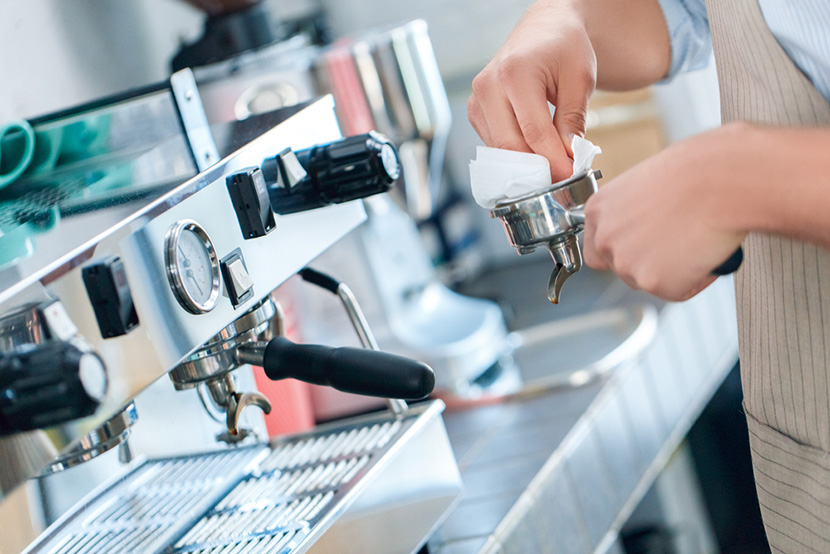Keeping it clean | Cleaning coffee machines and maintaining your workspace

It’s said that cleanliness is next to godliness and using this mantra in coffee making will ensure maintenance of a high standard. Just as using expertly roasted specialty coffee is important, working with well maintained equipment will mean nothing stands between the beans and a delicious cup of espresso.
It’s said that cleanliness is next to godliness and using this mantra in coffee making will ensure maintenance of a high standard. Just as using expertly roasted specialty coffee is important, working with well maintained equipment will mean nothing stands between the beans and a delicious cup of espresso.
The basic premise of espresso maintenance is simple: keep both the workspace and espresso machine meticulously clean. Doting over your espresso machine will reap rewards and the best baristas will value this aspect of coffee-making and appreciate its importance. Regular, simple cleaning will prevent the frustration that comes from producing mediocre coffee. Whether you are a professional or home barista, get into the habit of cleaning the espresso machine regularly to keep the coffee flavoursome.
Effects of poor maintenance
The same oils that are so coveted and produce that beautiful espresso flavour can also be the problem if left to accumulate. Oil remnants, which are black in colour, will go rancid and ruin the flavour of espresso. A telltale sign of improperly cleaned equipment is coffee with a burnt taste – a result of rancid coffee oil residue. Neglecting regular cleaning and maintenance can also affect the functionality of the machine and it may take longer to brew the coffee. Consistent neglect can eventually lead to a machine becoming completely blocked and it will no longer work. A milk wand which has not been properly maintained may also become blocked and will function very slowly, then eventually, not at all.
Keeping it clean
There was a time when baristas were taught that blackness in the bottom of the group handle should be left there because it added to the flavour. It is now common knowledge that this blackness is rancidity.
To prevent rancidity from affecting coffee, ensure that each component is continuously cleaned throughout the day. This includes the group handle and filter basket. In a café situation, cleaning should be done every hour. A scouring pad should be used to remove the oils until all the surfaces are spotless. For cafés, have a spare set of handles and rotate them throughout the day. Inside the group head is a shower filter, which will need to be removed and cleaned. A general rule of thumb is to clean the shower filter at least once a day.
Milk wands should be cleaned with each use. After finishing steaming the milk, wipe down the wand with a dedicated cleaning cloth and then quickly turn the steamer back on for a brief moment to completely purge the steam wand of any residue and ensure no milk is taken back into the boiler.
At the end of each day, each piece of equipment should be thoroughly cleaned with a specialty product such as Cafetto Espresso Clean.
Even if you are a home barista, pay attention to cleanliness. Wipe down the filter basket, shower spray and group handle when you’re done for the day to ensure they are ready for the next time. You can also use a product made for deep cleaning (Cafetto also makes a cleaner for home), although you’ll only need to use it about once a week, depending on how much coffee you brew.
Grinders should also be kept free from residue. Before new beans are placed in the hopper, wipe the oils out – if this is done regularly the oils should come off the surface quite easily.
Workspace basics
It pays to give tidiness and organisation a thought, particularly as a professional barista. A commercial workspace must be clean and tidy in order to enable an efficient system and effective workflow. Otherwise, you will find yourself lost and confused as soon as the pace picks up. Set up the machine, milk jugs and grinder in an optimal position. Also check that the brush, cloth, and tamper are in a good, logical spot. Make sure everything is set up so that not only can you make a good coffee, regardless of the volume, but you are able to keep the machine clean throughout the day.
In Australia, 90 per cent of beverages sold in a café are milk-based, so every barista should know that you can’t make a decent coffee with milk that’s been reheated. Reheating causes the proteins in the milk to break down, affects the milk’s sweetness and results in a watery consistency.
The barista’s repertoire at one time consisted of just one 2 litre milk jug, which was simply topped up with each coffee. Thankfully standards have risen and reheating is now frowned on. A barista will typically have jugs in varying sizes, so each coffee starts out with fresh milk which is steamed and poured until completion. In addition to different sizes, baristas also need a jug for each type of milk. With the large assortment of jugs required, it has become even more important for baristas to have an efficient system in place to ensure a smooth workflow.
Clean rewards
Although it may prove arduous at first, make the effort to establish a good cleaning regime and it will become second nature. For home baristas, think of the espresso machine as anything else in the kitchen – if you use it, clean it, and put it away clean. With the combination of freshly roasted specialty beans, a good grinder and clean, well-maintained equipment, you will be enjoying beautiful espresso every time.
The Coffee Institute’s range of barista courses cover this and all other coffee-brewing basics - sign up today.